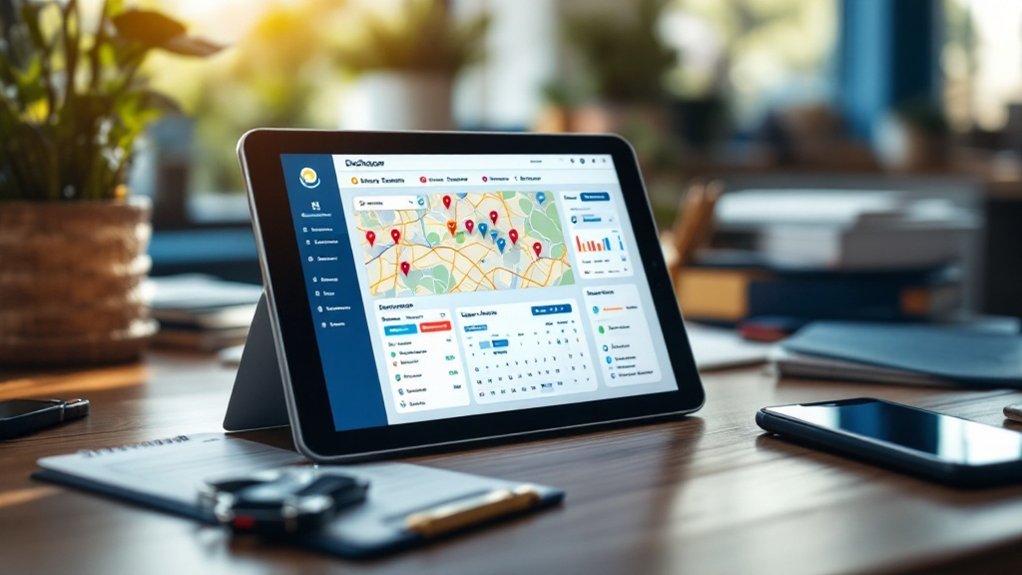Field service management software helps small businesses boost efficiency by digitizing work orders, scheduling, and customer management. These solutions typically include mobile apps for technicians, GPS tracking, and automated scheduling tools that can reduce manual errors by up to 90%. Cloud-based options offer affordable monthly pricing ($50-200 per user) while delivering 20-30% productivity gains. With proper implementation and training, businesses can expect annual savings of $25,000 or more – making it a valuable investment worth exploring further.
Quick Overview
- Cloud-based field service software reduces upfront costs while providing essential features like work order management and scheduling.
- Small businesses can expect ROI through 25-35% reduced administrative costs and 20-30% increased technician productivity.
- Mobile apps eliminate paperwork and improve efficiency by 30%, allowing technicians to access job information in real-time.
- User-friendly interfaces and role-specific training ensure quick team adoption and successful implementation.
- Integrated GPS tracking and scheduling automation improve first-time fix rates by 25% and reduce manual errors by 90%.
Understanding the Core Features of Field Service Management Software

Every successful field service business relies on a robust set of core features to manage daily operations effectively.
Modern field service software combines essential tools into one all-encompassing platform, making it easier for small businesses to streamline their workflows.
Field service platforms unify critical business tools, empowering small companies to optimize operations and enhance productivity through streamlined processes.
The foundation of these systems includes five key components: work order management for tracking jobs and assignments, scheduling and dispatching capabilities with GPS integration, mobile apps for field technicians, customer management tools, and detailed reporting features.
Work orders can be created and monitored in real-time, while intelligent scheduling guarantees ideal routing and technician deployment. These systems enhance service quality and profitability through efficient management of customer visits.
Mobile access allows field staff to update job status and access customer information on the go, while built-in analytics help businesses track performance and identify areas for improvement.
Selecting the Right Solution for Your Small Business
When small businesses begin searching for field service software, choosing the right solution requires careful consideration of multiple factors that can impact long-term success.
Business owners should start by clearly identifying their operational challenges and specific objectives before evaluating potential solutions. Cloud-based solutions offer significant advantages for small businesses with their lower upfront costs and automatic updates.
Key selection criteria should include:
- Core functionality alignment with business needs
- User-friendly interface for quick team adoption
- Scalability to accommodate future growth
- Integration capabilities with existing systems
- Mobile accessibility for field technicians
- Security features and data protection measures
The evaluation process must also factor in total cost of ownership, including implementation, training, and ongoing maintenance.
Small businesses should prioritize solutions that offer a balance of essential features, ease of use, and reasonable pricing while ensuring the software can effectively streamline their field service operations.
Maximizing Operational Efficiency Through Digital Tools

Modern field service software empowers small businesses to dramatically improve their operational efficiency through an integrated suite of digital tools.
These solutions deliver measurable improvements across key operational areas:
- Automated scheduling and dispatch systems reduce manual errors by 90% while optimizing technician routes for 20-30% fuel savings.
- Mobile apps enable field workers to access job information instantly, increasing efficiency by 30% and eliminating 30 minutes of daily paperwork.
- Real-time GPS tracking and digital forms improve first-time fix rates by 25% and decrease job completion times by 15%.
- Integrated inventory management reduces stockouts by 25% and unnecessary trips by 30%.
- Data analytics dashboards provide 80% better visibility into operations while saving managers up to 10 hours weekly on reporting tasks.
The implementation of comprehensive platforms enables seamless communication between field staff and headquarters, ensuring consistent service delivery and enhanced customer satisfaction.
Cost Analysis and Return on Investment
A thorough cost analysis reveals that field service software delivers substantial returns on investment for small businesses, despite initial implementation expenses.
While companies face upfront costs of $15,000 for implementation and $50-200 per user monthly, the financial benefits typically offset these investments within 6-12 months.
Small businesses with 1-15 technicians can expect annual savings of $25,000 or more through multiple efficiency gains, with popular solutions like RazorSync starting at $55 per technician monthly.
These improvements include a 20-30% increase in technician productivity, 15-20% better first-time fix rates, and a 10-15% reduction in fuel costs.
The software also reduces administrative overhead by 25-35% and cuts overtime expenses by up to 30%.
For growing companies, cloud-based solutions offer scalability advantages, while integrated data analytics help drive strategic decisions that further enhance ROI.
Best Practices for Implementation and Team Training

Successful implementation of field service software requires a carefully structured approach that combines thorough planning, team involvement, and extensive training.
Small businesses should start by identifying key stakeholders and forming a cross-functional implementation team to oversee the process. Setting clear and measurable success metrics helps track implementation progress and effectiveness.
For successful software rollout, build a diverse team representing all departments to guide the transformation journey.
A phased rollout strategy helps manage the shift effectively. Begin with a pilot program to test the software on a small scale, then gradually expand to the full team.
In-depth training is essential – develop role-specific materials, conduct hands-on sessions, and designate power users to support their colleagues.
Regular communication about implementation progress keeps everyone aligned and motivated.
To guarantee adoption success, address employee concerns early, highlight the benefits for both staff and customers, and celebrate milestone achievements throughout the implementation process.
Frequently Asked Questions
How Long Does It Take for Field Teams to Adapt to New Software?
Field teams typically take 2-4 weeks to master basic software functionality, while full proficiency requires 1-3 months.
Several factors influence adaptation speed, including software complexity, team experience, and training quality.
With proper support strategies like hands-on training and phased rollouts, teams can achieve measurable productivity improvements within 30-60 days.
Complete workflow integration generally takes up to 6 months, though this varies based on organizational readiness and implementation approach.
Can Field Service Software Work Offline in Areas With Poor Connectivity?
Yes, modern field service software includes robust offline capabilities.
Technicians can access customer information, work orders, and forms without an internet connection. When working offline, they can enter new data, update job statuses, and complete documentation – all of which automatically syncs once connectivity is restored.
This functionality is especially valuable for teams working in remote areas, underground locations, or places with unreliable internet service, ensuring continuous productivity regardless of connection status.
What Security Measures Protect Customer Data in Field Service Applications?
When it comes to protecting customer data, field service applications leave no stone unturned.
These systems employ robust security measures including 256-bit encryption for stored information, end-to-end encryption during transmission, and role-based access controls.
Multi-factor authentication prevents unauthorized access, while real-time monitoring detects suspicious activity.
Additionally, compliance with standards like GDPR, HIPAA, and PCI DSS guarantees data handling meets strict regulatory requirements.
How Often Are Software Updates Released and Are They Included?
Field service software updates are typically released 2-4 times per year, with major updates occurring bi-annually or quarterly depending on the vendor.
Cloud-based solutions usually include updates in the subscription cost and deliver them automatically.
Most vendors release minor updates monthly for bug fixes and security patches.
For SaaS solutions, updates are generally included in the subscription price, while on-premises systems might require separate upgrade purchases.
Can Multiple Field Teams Use the Same Mobile Device for Different Shifts?
Yes, multiple field teams can share mobile devices across different shifts, creating a harmonious workflow that maximizes resource efficiency.
Modern device management software enables secure user profiles, ensuring each team member has a personalized experience while maintaining data privacy.
Key requirements include:
- Proper check-in/check-out procedures
- Cloud-based data syncing
- Clear usage guidelines
- Regular device sanitization
This approach helps reduce hardware costs while maintaining operational effectiveness through careful device management and clear protocols.
Conclusion
Field service software illuminates the path to small business success like a beacon guiding ships to shore. When properly selected and implemented, these digital tools transform chaotic scheduling and paperwork into streamlined operations. By carefully weighing features against costs, training teams effectively, and following implementation best practices, small businesses can harness the full potential of field service management solutions to drive growth and customer satisfaction.








